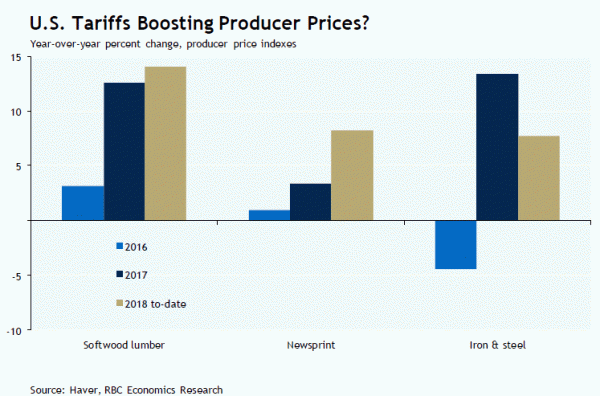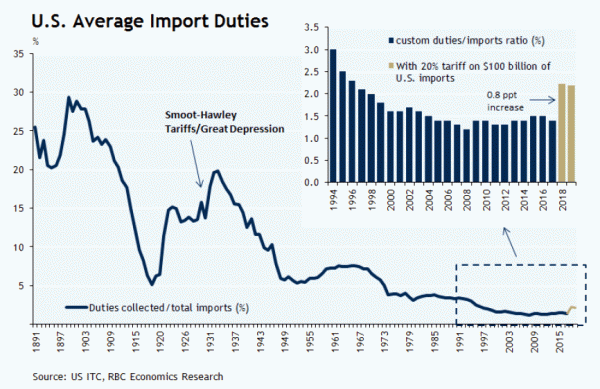The direct impact is manageable, but there’s reason to fear a trade escalation
The U.S. looks set to impose steep tariffs on Canadian steel and aluminum products on June 1 after Commerce Secretary Wilbur Ross announced that the temporary exemption Canada had secured would expire as scheduled. The tariffs, which the U.S. will also levy on allies including Mexico and the European Union, will likely have a moderately negative but manageable impact on all countries involved. The broader risk is that the U.S. tariffs, and the retaliatory trade measures they give rise to, will ultimately turn into a global trade war. We’re still a long way from that outcome, despite all the rhetoric. But the tariffs just add to uncertainty about the future, and that’s not good for business investment.
Putting steel tariffs in context
Almost 90% of Canadian steel and aluminum exports go to the U.S., so clearly the new tariffs will have an impact on those industries. Steel and aluminum production targeted directly by the new tariffs doesn’t represent a big share of the Canadian economy. By our count, about half of Canada’s steel and three-quarters of aluminum exports will be impacted by the tariffs — amounting to about 3% of Canada’s total exports. Regionally, Ontario and Quebec are disproportionately affected. Ontario accounts for about 80% of Canadian steel exports. Quebec accounts for around 75% of aluminum exports. Combined steel and aluminum production together accounts for about 0.5% of Canadian GDP and jobs.
U.S. producers will probably pay big part of upfront costs
The main impact of higher U.S. tariffs to date has been higher U.S. prices. The U.S. has already imposed significant tariffs on Canadian softwood lumber and newsprint, for example, in addition to steel tariffs levied earlier on a select group of countries, notably China and Russia. U.S. prices have spiked higher for all of those products. Import tariffs are typically framed as an attack on another country’s exports. Much of the cost, though, is ultimately paid by domestic rather than foreign producers and consumers. A weaker Canadian dollar could also offset some of the impact on demand for Canadian products from the tariffs.
Downstream impact not necessarily all negative
If they work as intended, the tariffs will hurt Canadian steel and aluminum producers by lowering the price of steel and aluminum in Canada. But for any business using those products as an input, that’s actually a good thing — and many more workers are in industries that build things from metal than produce metal themselves. The manufacturing sector, for example, is still ~10% of the Canadian economy. The highly integrated nature of U.S. and Canadian production chains muddy the picture. Steel tariffs will further increase the price of U.S. steel and in highly integrated industries it will be difficult for Canadian businesses to avoid higher prices as U.S. producers are forced to pass on part of their higher raw material costs into prices they charge Canadian customers for intermediate goods further up the value chain. The auto sector, a large consumer of steel, is probably the poster child for this type of disruption.
Part of the secondary impact of the Trump tariffs will also be in the form of higher Canadian import prices, as Canada, along with Mexico and Europe, respond with retaliatory measures. Canada has already announced intentions to levy tariffs on $16.6 billion of goods from the U.S. — matching the value of Canada’s 2017 exports impacted by the U.S. tariffs. That will mean higher prices for Canadian importers, but the amount is still only ~2% of Canada’s annual imports, so the broader consumer price impact won’t be that large. Trade officials are typically savvy enough to design retaliatory measures to have maximum political impact abroad and mini-mum impact on the domestic economy.
The tariffs mean more uncertainty for businesses
Perhaps the most important message from tariffs is that they are based on flimsy rationale — and that makes it difficult to predict which industry might be next. In this case, the U.S. has justified the tariffs on national security grounds, a questionable position giv-en that Canada, Mexico, and Europe are all U.S. allies. The U.S. also explicitly tied the hike in tariffs for Mexico and Canada to fail-ure to come to an agreement on NAFTA before the end of May. But if the point was to target NAFTA partners, then why steel? The U.S. was a net exporter of steel to both Canada and Mexico last year. Not knowing which industry could be next means any industry could be next, and that means more uncertainty for all trade-intensive businesses.
Are we in for a global trade war?
That’s a ways off. Yes, the anti-trade rhetoric from the Trump administration represents a sharp departure from what we’re used to hearing from U.S. presidents. But even including potential tariffs on $50 billion of imports from China, the effective tariff rate from the U.S. will still be quite low. By our math, custom duties collected could increase to just over 2% of imports based on measures announced to date, up from about 1 1/2% last year. So while, an across-the-board tariff hike of around 0.8 of a percentage point doesn’t qualify as a global trade war, sabres are rattling.















